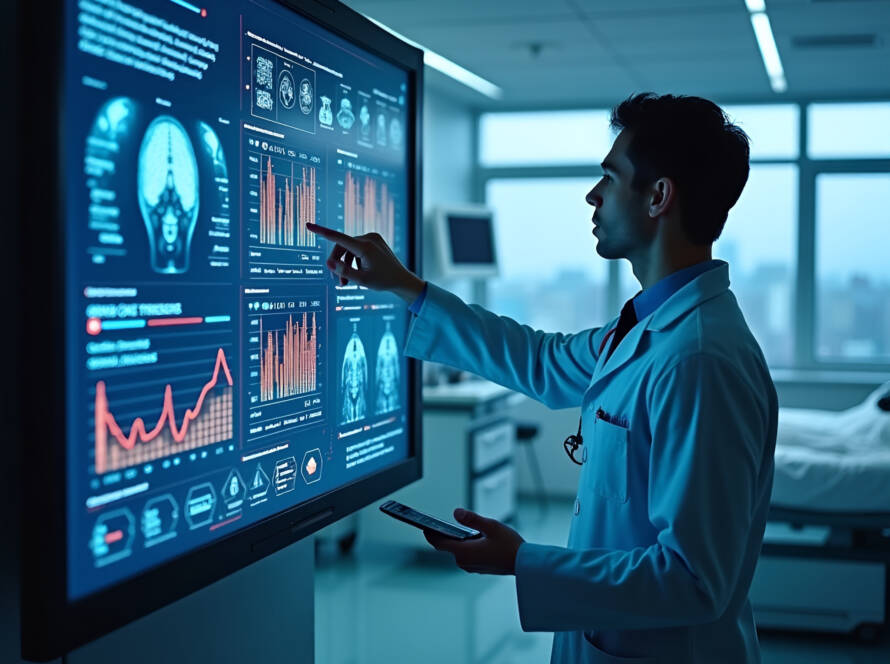The healthcare industry is facing enormous challenges—rising costs, staffing shortages, and the increasing demand for high-quality care. Every day, hospitals and clinics struggle to deliver better patient care while keeping their budgets in check. It might seem impossible to balance these competing pressures, but artificial intelligence (AI) is emerging as a powerful solution.
AI is no longer just a futuristic concept; it’s here and making a difference in healthcare. From cutting operational costs to improving patient outcomes, AI is reshaping the way healthcare systems operate. But how exactly is this happening?
Streamlining Administrative Tasks with AI
Running a healthcare facility involves mountains of paperwork and countless administrative tasks—scheduling appointments, managing patient records, handling billing, and more. Traditionally, these tasks required large administrative teams and were often bogged down by human error and inefficiencies. But AI is changing that.
Imagine an AI-powered system that automatically schedules patient appointments, preventing double bookings and reducing no-shows. Or consider AI taking over the tedious task of managing billing and claims processing, ensuring fewer mistakes and faster reimbursements. These are the kinds of real-world solutions AI offers.
Not only does this reduce the burden on human staff, but it also cuts down on operational costs. Fewer people are needed to manage these tasks, and AI systems tend to make fewer errors. For healthcare providers, that means saving both time and money.
Enhancing Diagnostics and Treatment
One of the most promising uses of AI in healthcare is in diagnostics. AI algorithms can analyze medical images like X-rays, MRIs, and CT scans with incredible precision—often detecting abnormalities that might be missed by the human eye. Early detection of conditions like cancer or heart disease can make a huge difference in treatment outcomes.
For instance, AI can scan thousands of images in a fraction of the time it would take a human doctor, flagging anything suspicious for further review. This doesn’t replace healthcare professionals but enhances their ability to catch potential issues early, leading to faster and more accurate diagnoses. As a result, patients get the care they need sooner, reducing the cost of treating advanced-stage diseases and improving overall outcomes.
Additionally, AI can assist in personalized treatment plans. By analyzing patient data, including genetic information, AI can help doctors tailor treatments that are more likely to succeed for individual patients. This reduces trial-and-error in prescribing medications and improves the overall effectiveness of care.
Improving Patient Care with Fewer Resources
Staff shortages are a major issue in healthcare today. Many hospitals and clinics struggle to provide the same level of care with fewer hands on deck. Here’s where AI can step in, helping facilities do more with less.
One way AI achieves this is through virtual health assistants. These AI-powered systems can handle routine tasks like answering patient questions, scheduling appointments, and sending medication reminders. Patients can interact with these virtual assistants 24/7, which frees up healthcare staff to focus on more critical tasks.
Remote monitoring is another area where AI is making a huge impact. Patients with chronic conditions, for example, can use wearable devices that track vital signs, such as heart rate or blood sugar levels. AI systems can monitor these readings in real-time, alerting healthcare providers to any concerning changes. This allows doctors to intervene earlier, preventing costly hospitalizations and ensuring patients receive timely care, even from a distance.
Boosting Revenue with AI
Beyond cutting costs, AI is also driving revenue growth for healthcare providers. One of the biggest ways it does this is by improving efficiency, allowing healthcare organizations to see more patients without sacrificing the quality of care.
For example, AI helps streamline appointment scheduling. AI-powered tools can send reminders to patients, reducing missed appointments and cancellations—both of which can cause significant financial losses for healthcare providers. AI can even predict which patients are most likely to miss their appointments and offer solutions to prevent it, such as more flexible scheduling or reminder alerts.
AI also plays a role in faster diagnoses, which means patients can be treated more quickly. The sooner patients are diagnosed and treated, the more healthcare providers can increase their patient throughput, directly leading to higher revenue.
Moreover, by using predictive analytics, AI can help healthcare providers identify at-risk patients early, allowing them to offer preventive care. This not only improves patient outcomes but also creates a steady stream of care, which can boost revenue over time.
Challenges and Opportunities
Of course, implementing AI in healthcare isn’t without its challenges. One of the biggest concerns is privacy and compliance, especially with strict regulations like HIPAA in place. Ensuring that patient data remains secure while integrating AI systems is a critical issue healthcare organizations must navigate.
However, the benefits of AI far outweigh the challenges. The potential for cost savings, better patient outcomes, and increased revenue make AI an essential tool for healthcare providers moving forward. By embracing AI, healthcare systems can provide higher-quality care while managing resources more efficiently.
A Brighter Future for Healthcare
Picture a healthcare system where technology quietly works in the background, helping reduce costs while improving patient care. AI is making that dream a reality. From automating tedious tasks to enhancing diagnostics and treatment, AI offers a way to deliver better care with fewer resources.
While it may seem like an optimistic vision, AI has the power to transform healthcare for the better. With AI, the future of healthcare looks brighter than ever—one where patient care is more efficient, affordable, and accessible to all.


